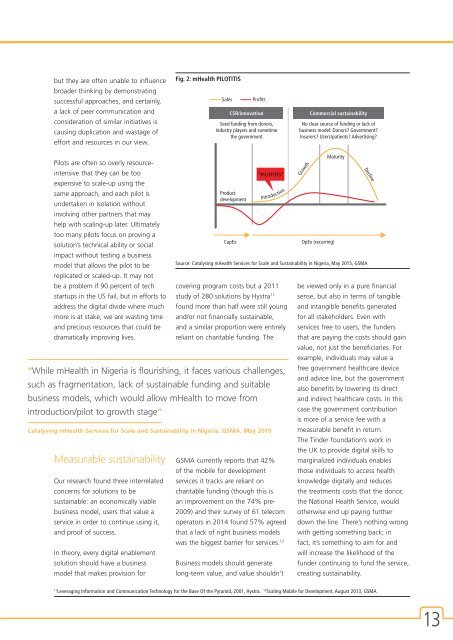Digital Enablement
1ZoIvug
1ZoIvug
You also want an ePaper? Increase the reach of your titles
YUMPU automatically turns print PDFs into web optimized ePapers that Google loves.
ut they are often unable to influence<br />
broader thinking by demonstrating<br />
successful approaches, and certainly,<br />
a lack of peer communication and<br />
consideration of similar initiatives is<br />
causing duplication and wastage of<br />
effort and resources in our view.<br />
Fig. 2: mHealth PILOTITIS<br />
Sales<br />
Profits<br />
CSR/innovation<br />
Seed funding from donors,<br />
industry players and sometime<br />
the government<br />
Commercial sustainability<br />
No clear source of funding or lack of<br />
business model: Donors? Government?<br />
Insurers? Users/patients? Advertising?<br />
Pilots are often so overly resourceintensive<br />
that they can be too<br />
expensive to scale-up using the<br />
same approach, and each pilot is<br />
undertaken in isolation without<br />
involving other partners that may<br />
help with scaling-up later. Ultimately<br />
too many pilots focus on proving a<br />
solution’s technical ability or social<br />
impact without testing a business<br />
model that allows the pilot to be<br />
replicated or scaled-up. It may not<br />
be a problem if 90 percent of tech<br />
startups in the US fail, but in efforts to<br />
address the digital divide where much<br />
more is at stake; we are wasting time<br />
and precious resources that could be<br />
dramatically improving lives.<br />
Measurable sustainability<br />
Our research found three interrelated<br />
concerns for solutions to be<br />
sustainable: an economically viable<br />
business model, users that value a<br />
service in order to continue using it,<br />
and proof of success.<br />
In theory, every digital enablement<br />
solution should have a business<br />
model that makes provision for<br />
Product<br />
development<br />
CapEx<br />
covering program costs but a 2011<br />
study of 280 solutions by Hystra 11<br />
found more than half were still young<br />
and/or not financially sustainable,<br />
and a similar proportion were entirely<br />
reliant on charitable funding. The<br />
GSMA currently reports that 42%<br />
of the mobile for development<br />
services it tracks are reliant on<br />
“PILOTITIS”<br />
charitable funding (though this is<br />
an improvement on the 74% pre-<br />
2009) and their survey of 61 telecom<br />
operators in 2014 found 57% agreed<br />
that a lack of right business models<br />
was the biggest barrier for services. 12<br />
Business models should generate<br />
Introduction<br />
long-term value, and value shouldn’t<br />
OpEx (recurring)<br />
Maturity<br />
Source: Catalysing mHealth Services for Scale and Sustainability in Nigeria, May 2015, GSMA<br />
“While mHealth in Nigeria is flourishing, it faces various challenges,<br />
such as fragmentation, lack of sustainable funding and suitable<br />
business models, which would allow mHealth to move from<br />
introduction/pilot to growth stage“<br />
Catalysing mHealth Services for Scale and Sustainability in Nigeria. GSMA, May 2015<br />
Growth<br />
be viewed only in a pure financial<br />
sense, but also in terms of tangible<br />
and intangible benefits generated<br />
for all stakeholders. Even with<br />
services free to users, the funders<br />
that are paying the costs should gain<br />
value, not just the beneficiaries. For<br />
example, individuals may value a<br />
free government healthcare device<br />
and advice line, but the government<br />
also benefits by lowering its direct<br />
and indirect healthcare costs. In this<br />
case the government contribution<br />
is more of a service fee with a<br />
measurable benefit in return.<br />
The Tinder foundation’s work in<br />
the UK to provide digital skills to<br />
marginalized individuals enables<br />
those individuals to access health<br />
knowledge digitally and reduces<br />
the treatments costs that the donor,<br />
the National Health Service, would<br />
otherwise end up paying further<br />
down the line. There’s nothing wrong<br />
with getting something back; in<br />
fact, it’s something to aim for and<br />
will increase the likelihood of the<br />
funder continuing to fund the service,<br />
creating sustainability.<br />
Decline<br />
11<br />
Leveraging Information and Communication Technology for the Base Of the Pyramid, 2001, Hystra. 12 Scaling Mobile for Development, August 2013, GSMA<br />
13




